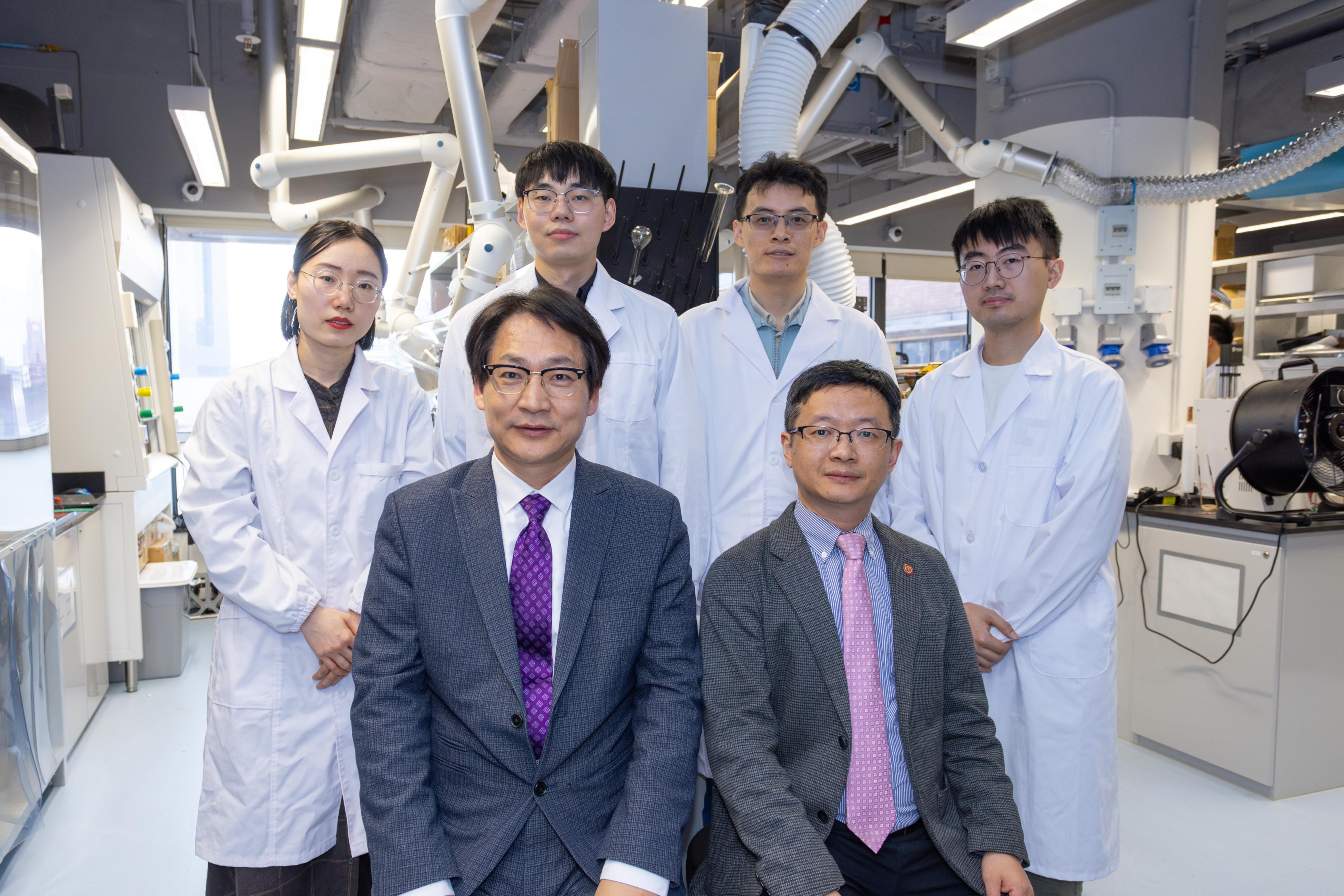A
research
team
led
by
Prof.
Zuankai
Wang,
Associate
Vice
President
(Research
and
Innovation),
Kuok
Group
Professor
in
Nature-Inspired
Engineering
and
Chair
Professor
of
the
PolyU
Department
of
Mechanical
Engineering
(front
row,
left),
and
Prof.
Haimin
Yao,
Associate
Professor
of
the
PolyU
Department
of
Mechanical
Engineering
(front
row,
right),
has
invented
a
self-powered
mechanism
of
freezing
droplet
ejection
that
allows
droplets
to
shoot
themselves
away.
Research
team
members
include
Postdoctoral
Fellow
Dr
Huanhuan
Zhang
(back
row,
1st
from
left),
PhD
student
Mr
Wei
Zhang
(back
row,
2nd
from
left),
Research
Assistant
Professor
Dr
Yuankai
Jin
(back
row,
2nd
from
right),
and
PhD
student
Mr
Chenyang
Wu
(back
row,
1st
from
right).
Published
in
Nature
Chemical
Engineering
as
the
cover
feature
for
its
last
December
issue,
the
research
project
“Freezing
droplet
ejection
by
spring-like
elastic
pillars”
is
led
by
Prof.
Zuankai
WANG,
Associate
Vice
President
(Research
and
Innovation),
Kuok
Group
Professor
in
Nature-Inspired
Engineering
and
Chair
Professor
of
the
PolyU
Department
of
Mechanical
Engineering,
and
Prof.
Haimin
YAO,
Associate
Professor
of
the
PolyU
Department
of
Mechanical
Engineering.
First
co-authors
include
Postdoctoral
Fellow
Dr
Huanhuan
ZHANG,
PhD
student
Mr
Wei
ZHANG,
Research
Assistant
Professor
Dr
Yuankai
JIN,
and
PhD
student
Mr
Chenyang
WU.
The discovery of the self-ejection phenomenon in freezing droplets was inspired by a fungus capable of shooting its spores away through osmosis-induced volume expansion. Noting that a similar volume expansion occurs when water droplet is freezing, the research team has replicated the self-shooting mechanism found in the fungi and developed a structured elastic surface (SES) with spring-like pillars and wetting contrast that allows for the spontaneous ejection of freezing water droplets.
The SES structure is designed to accelerate the ejection velocity and enlarge the kinetic energy transformation of freezing droplets. When the freezing droplet undergoes volume expansion, it compresses the pillar of SES. The volume expansion work is first converted to and stored as elastic energy in the pillar within tens of seconds, and then to be transformed into the droplet’s kinetic energy rapidly within milliseconds. This thousandfold reduction in timescales leads to sufficient kinetic energy to drive freezing droplet ejection.
The simple SES structure, after parameter design, is effective in ejecting freezing droplets without external energy input and even against the forces of wind and gravity. It can be applied to aircraft, wind blades or cable lines to prevent hazards caused by ice accretion. Dr Huanhuan Zhang said, “It is exciting that we, for the first time, introduce a self-powered ice removal concept that will offer a wide range of innovative solutions. We will continuously improve the design of SES, allowing it to be manufactured at various scales and at a low cost to meet societal needs.”
Furthermore, the theoretical model developed in the research elucidates the factors determining the successful onset of the freezing droplet ejection phenomenon, with scalable design exhibiting potential practicability in various fields.
Prof. Wang envisions, “This nature-inspired research paved the way for numerous impactful applications. We believe that the freezing droplet ejection, as a prototype, could stimulate the development of self-powered concepts and methods for a wide range of purposes such as de-icing, energy harvesting and soft robotic applications.”
Specifically, droplet ejection induced by volume expansion enhances understanding of multi-phase freezing dynamics for anti-icing applications. Prof. Yao remarked, “Our research demonstrates a strategy to efficiently harness and utilise the volume expansion work of freezing droplets to generate ballistic motion. This could subsequently expand the application of energy conversion phenomena, and inspire the development of droplet-based energy generators and soft robotic catapults.”
Hashtag: #PolyU #Nature-inspiredResearch #De-icing #SoftRobotics #香港理工大学 #仿生研究 #除冰 #飞机积冰 #软件机器人
The issuer is solely responsible for the content of this announcement.
Support InfoStride News' Credible Journalism: Only credible journalism can guarantee a fair, accountable and transparent society, including democracy and government. It involves a lot of efforts and money. We need your support. Click here to Donate
